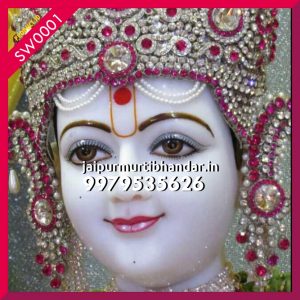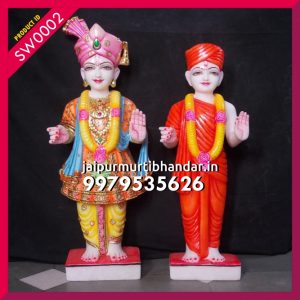-
Swaminarayan : SW-0001
The Swaminarayan Sampraday began as the Uddhav Sampraday and was led by Ramanand Swami. In 1799, Swaminarayan, born as Ghanshyam Pande, was initiated into the Uddhav Sampraday as an ascetic (Sadhu) by his guru, Ramanand Swami, and given the name “Sahajanand Swami”. At the age of 21, Neelkanth Varni was given the leadership of the sect known as Uddhav Sampraday with the blessings of Ramanand Swami, who handed him control of the religious diocese shortly before his death. Fourteen days after Ramanand Swami died, Neelkanth Varni, now known as Sahajanand Swami, held a large gathering of followers at the town of Faneni. It was during this meeting that Swaminarayan introduced what he termed “the father of all Mantras” and described it as “maha” (or great).[8] Then he was known as Swaminarayan, and the name “Swaminarayan Sampraday” came into existence.
At the age of 49, Swaminarayan took Samadhi at Gadhada in 1830 and died, after he promised to remain within the Swaminarayan Sampraday in the images he installed (and by the Acharyas succeeding him), the Acharyas and saints installed by him (and those in direct succession), the saints he initiated (and those initiated by succeeding Acharyas) and the scriptures, such as Shikshapatri, Vachanamrut, Satsangi Jeevan, Nishkhulanand Kavya and Yamdand (and those authorised by succeeding Acharyas).
-
Swaminarayan : SW-0002
The Swaminarayan Sampraday began as the Uddhav Sampraday and was led by Ramanand Swami. In 1799, Swaminarayan, born as Ghanshyam Pande, was initiated into the Uddhav Sampraday as an ascetic (Sadhu) by his guru, Ramanand Swami, and given the name “Sahajanand Swami”. At the age of 21, Neelkanth Varni was given the leadership of the sect known as Uddhav Sampraday with the blessings of Ramanand Swami, who handed him control of the religious diocese shortly before his death. Fourteen days after Ramanand Swami died, Neelkanth Varni, now known as Sahajanand Swami, held a large gathering of followers at the town of Faneni. It was during this meeting that Swaminarayan introduced what he termed “the father of all Mantras” and described it as “maha” (or great).[8] Then he was known as Swaminarayan, and the name “Swaminarayan Sampraday” came into existence.
At the age of 49, Swaminarayan took Samadhi at Gadhada in 1830 and died, after he promised to remain within the Swaminarayan Sampraday in the images he installed (and by the Acharyas succeeding him), the Acharyas and saints installed by him (and those in direct succession), the saints he initiated (and those initiated by succeeding Acharyas) and the scriptures, such as Shikshapatri, Vachanamrut, Satsangi Jeevan, Nishkhulanand Kavya and Yamdand (and those authorised by succeeding Acharyas).
-
Swaminarayan : SW-0003
The Swaminarayan Sampraday began as the Uddhav Sampraday and was led by Ramanand Swami. In 1799, Swaminarayan, born as Ghanshyam Pande, was initiated into the Uddhav Sampraday as an ascetic (Sadhu) by his guru, Ramanand Swami, and given the name “Sahajanand Swami”. At the age of 21, Neelkanth Varni was given the leadership of the sect known as Uddhav Sampraday with the blessings of Ramanand Swami, who handed him control of the religious diocese shortly before his death. Fourteen days after Ramanand Swami died, Neelkanth Varni, now known as Sahajanand Swami, held a large gathering of followers at the town of Faneni. It was during this meeting that Swaminarayan introduced what he termed “the father of all Mantras” and described it as “maha” (or great).[8] Then he was known as Swaminarayan, and the name “Swaminarayan Sampraday” came into existence.
At the age of 49, Swaminarayan took Samadhi at Gadhada in 1830 and died, after he promised to remain within the Swaminarayan Sampraday in the images he installed (and by the Acharyas succeeding him), the Acharyas and saints installed by him (and those in direct succession), the saints he initiated (and those initiated by succeeding Acharyas) and the scriptures, such as Shikshapatri, Vachanamrut, Satsangi Jeevan, Nishkhulanand Kavya and Yamdand (and those authorised by succeeding Acharyas).
Swaminarayan
- Home
- Shop
- Marble Statue
- God Idols
- Swaminarayan

 +91 9979 535 626
+91 9979 535 626


